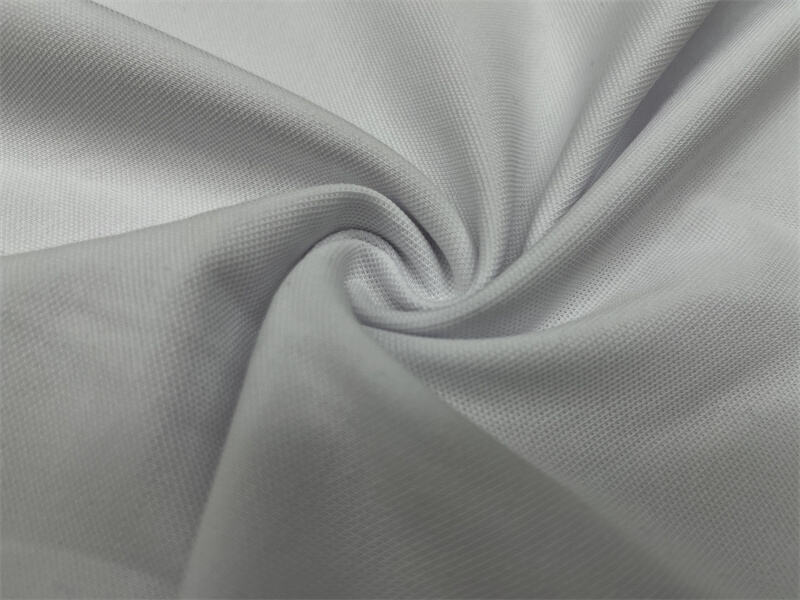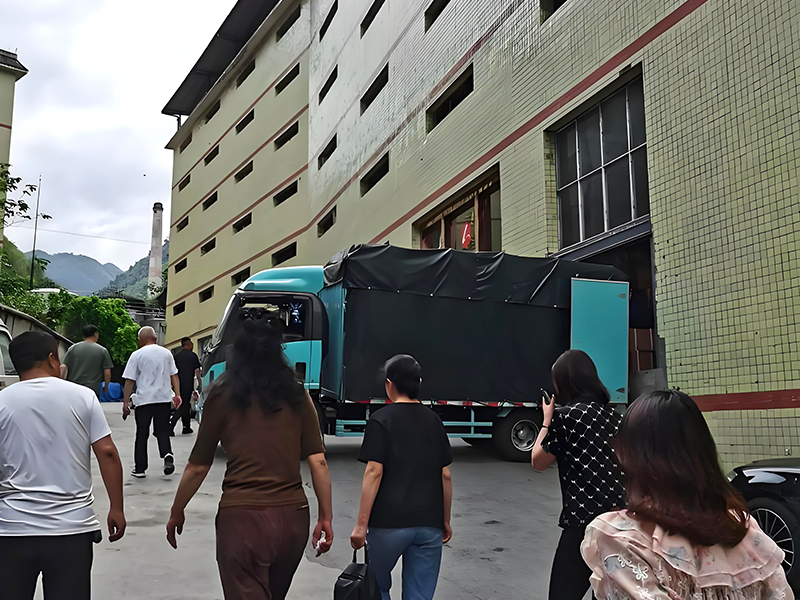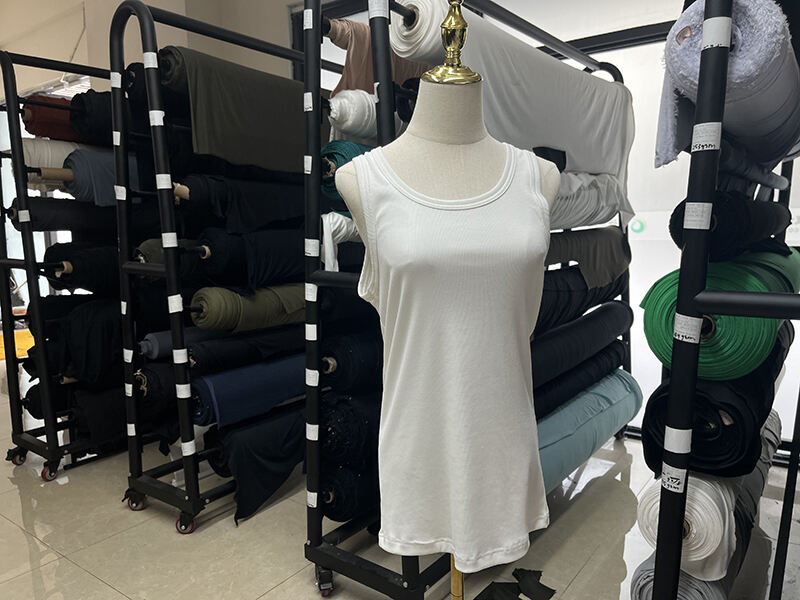Discover the differences between bamboo and cotton fabrics. Compare sustainability, comfort, durability, and care to choose the best material for your clothing, bedding, or towels.
Table of Contents
-
Why Choose Between Bamboo and Cotton Fabrics?
-
How Are Bamboo and Cotton Fabrics Produced?
-
Bamboo vs. Cotton: Key Differences
-
Benefits and Drawbacks of Bamboo Fabric
-
Benefits and Drawbacks of Cotton Fabric
-
Which Fabric Is Best for Your Lifestyle?
-
How to Care for Bamboo and Cotton Fabrics
-
FAQs About Bamboo and Cotton Fabrics
Why Choose Between Bamboo and Cotton Fabrics?
With growing interest in sustainable and comfortable textiles, choosing the right fabric is more important than ever. Bamboo and cotton are top contenders for clothing, bedding, and towels, each offering unique benefits. Whether you’re focused on eco-friendliness, skin sensitivity, or long-term durability, this guide compares bamboo and cotton to help you decide. Learn which fabric aligns with your needs and values, from sustainability to everyday comfort.
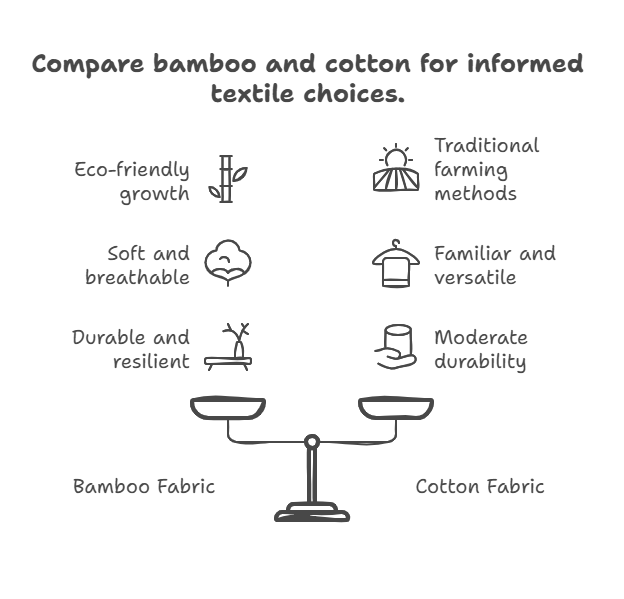
How Are Bamboo and Cotton Fabrics Produced?
Bamboo Fabric Production
Bamboo fabric is derived from the fast-growing bamboo plant, a renewable resource. The production process includes:
-
Harvesting: Bamboo stalks are cut and crushed.
-
Fiber Extraction:
-
Mechanical: Bamboo is crushed and treated with natural enzymes to produce soft, eco-friendly fibers. This method is sustainable but labor-intensive.
-
Chemical: Bamboo is dissolved using chemicals to create bamboo rayon or viscose, a common but less environmentally friendly process due to chemical waste.
-
-
Spinning and Weaving: Fibers are spun into yarn and woven into soft, silky fabric.
Note: Chemical processing, while producing luxurious bamboo rayon, can reduce the environmental benefits of bamboo’s rapid growth. Look for certifications like OEKO-TEX for greener options.
Cotton Fabric Production
Cotton is sourced from the fluffy fibers of cotton plant seeds. Its production is straightforward:
-
Harvesting: Cotton bolls are collected from plants.
-
Ginning: Seeds are separated, leaving raw cotton fibers.
-
Spinning: Fibers are cleaned, carded, and spun into threads.
-
Weaving/Knitting: Threads are woven or knitted into fabric, such as percale or sateen.
Cotton requires less processing than bamboo but is resource-intensive, demanding significant water and pesticides unless organic.
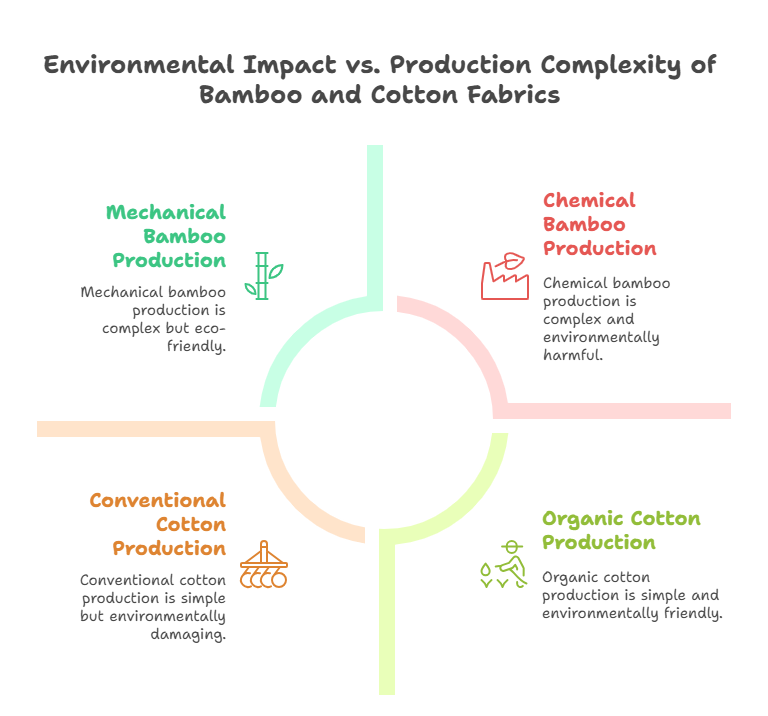
Bamboo vs Cotton: Key Differences
|
Feature |
Bamboo Fabric |
Cotton Fabric |
Common Uses |
|---|---|---|---|
|
Source |
Extracted from bamboo stalks |
Grown on cotton plants |
Clothing, bedding, towels |
|
Texture |
Silky, soft (especially bamboo rayon) |
Soft, varies by weave (e.g., sateen) |
T-shirts, sheets, denim |
|
Sustainability |
Grows quickly, uses less water |
Water-intensive, slower growth |
Towels, activewear, upholstery |
|
Durability |
Less durable, prone to pilling |
Highly durable, long-lasting |
Workwear, bedding, outerwear |
|
Hypoallergenic |
Naturally hypoallergenic |
Can be, depends on processing |
Baby clothes, medical textiles |
|
Cost |
Often more expensive |
Generally more affordable |
Everyday clothing, budget bedding |
Bamboo’s rapid growth makes it a sustainable choice, requiring up to 20% less water than cotton cultivation (Source: Textile Exchange). However, its chemical processing can offset eco-benefits. Cotton, while durable, often relies on pesticides, impacting its environmental footprint.
Benefits and Drawbacks of Bamboo Fabric
Benefits
-
Sustainable Growth: Bamboo regenerates quickly, needing fewer resources than cotton.
-
Luxuriously Soft: Bamboo rayon offers a silky texture, ideal for sensitive skin.
-
Hypoallergenic: Naturally resists bacteria and allergens, perfect for allergy-prone individuals.
-
Moisture-Wicking: Keeps you cool and dry, great for warm climates.
Drawbacks
-
Chemical Processing: Most bamboo fabrics (rayon/viscose) involve chemicals, which can harm the environment.
-
Lower Durability: May pill or wear out faster than cotton with frequent use.
-
Higher Cost: Processing makes bamboo pricier than standard cotton.
Consumer Feedback: Users love bamboo’s softness for bedding but note occasional pilling after multiple washes.
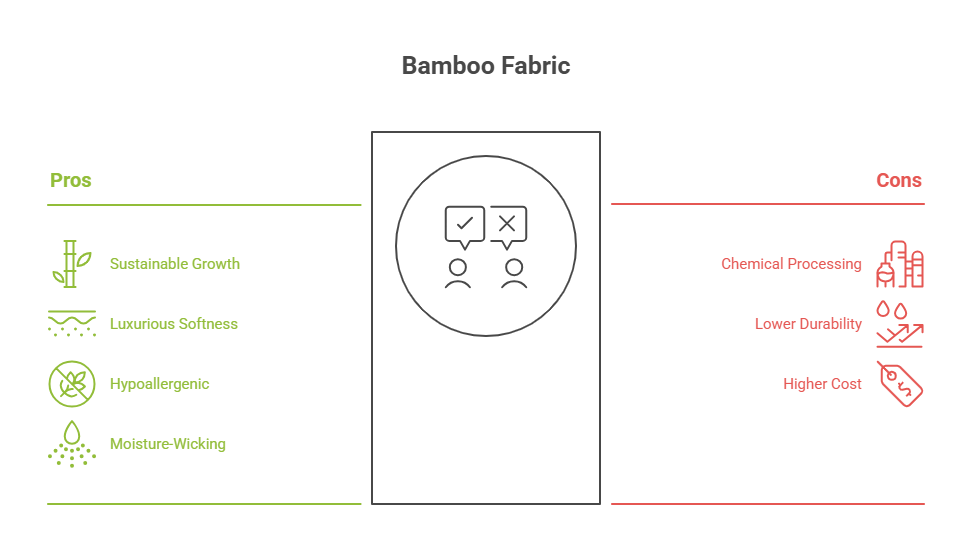
Benefits and Drawbacks of Cotton Fabric
Benefits
-
Highly Durable: Withstands heavy use and frequent washing, ideal for daily wear.
-
Versatile: Available in weaves like twill or flannel, catering to various needs.
-
Cost-Effective: Widely available at budget-friendly prices.
-
Breathable: Allows airflow, suitable for hot and humid environments.
Drawbacks
-
Environmental Impact: Cotton farming uses significant water (up to 2,700 gallons per pound, per WWF) and pesticides.
-
Initial Texture: May feel less soft until broken in through washing.
-
Allergen Risk: Non-organic cotton may irritate sensitive skin.
Consumer Feedback: Shoppers praise cotton’s durability for towels and jeans but wish organic options were more affordable.
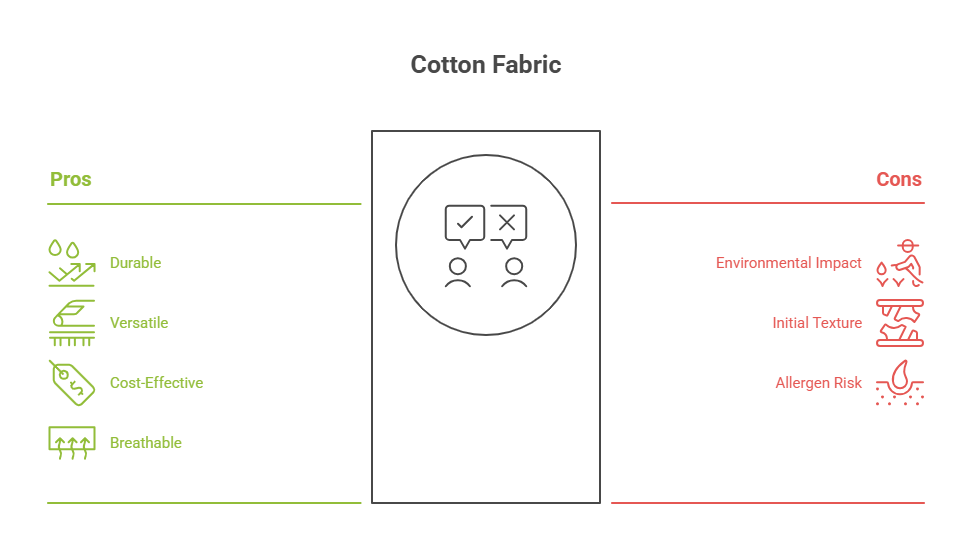
Which Fabric Is Best for Your Lifestyle?
Choose Bamboo Fabric If:
-
You prioritize sustainability and prefer eco-friendly materials like bamboo rayon or mechanically processed bamboo.
-
You have sensitive skin or allergies, as bamboo is naturally hypoallergenic.
-
You want soft, breathable fabrics for bedding or loungewear in warm climates.
Scenario: Sarah, a new mom in a humid climate, chose bamboo viscose sheets for her baby’s crib. Their hypoallergenic properties and moisture-wicking ability keep her infant comfortable and rash-free during hot nights.
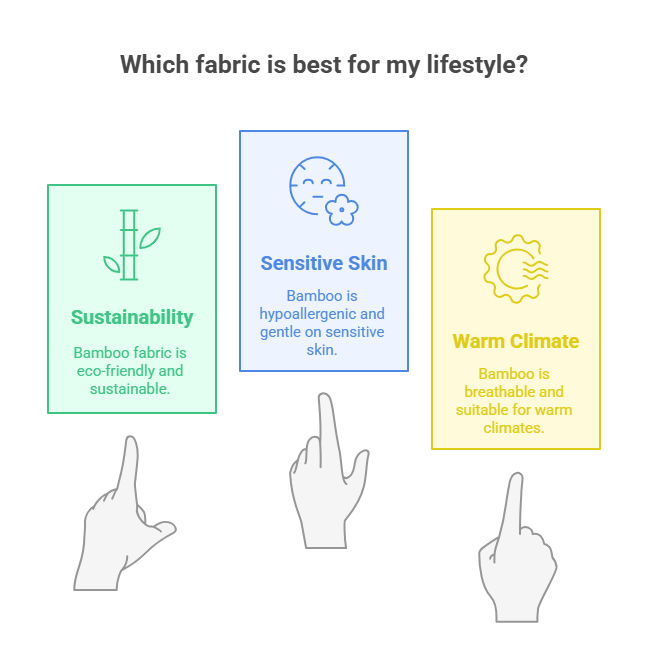
Choose Cotton Fabric If:
-
You need durable, long-lasting fabrics for heavy-use items like towels or workwear.
-
You’re budget-conscious and want versatile, affordable options.
-
You prefer classic textures for everyday clothing or crisp bedding.
Scenario: Mark, an avid camper, opted for organic cotton towels for his outdoor trips. Their durability holds up to rough use, and their affordability fits his budget for frequent replacements.
Expert Insight: “Bamboo rayon is a game-changer for luxury bedding due to its softness, but cotton’s durability makes it a staple for high-wear items like denim,” says textile designer Laura Chen.
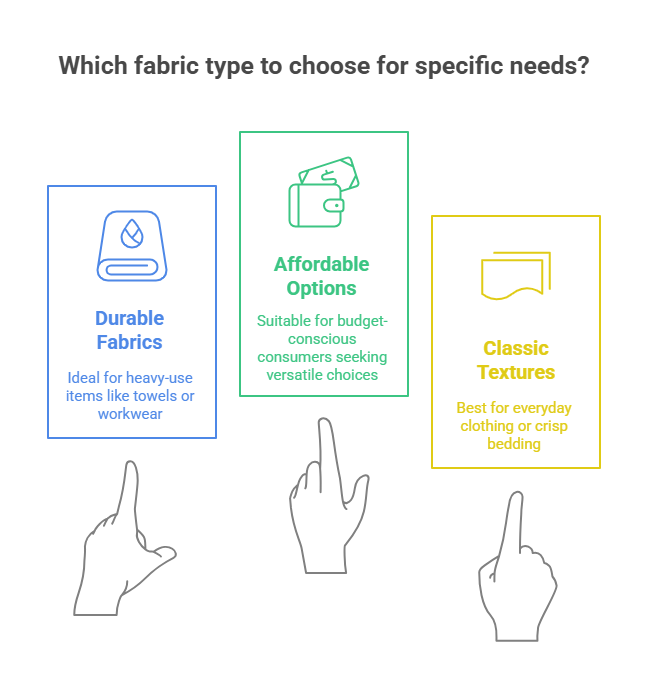
How to Care for Bamboo and Cotton Fabrics
Proper care extends the lifespan of your fabrics, reducing environmental impact by minimizing replacements.
Bamboo Fabric Care
-
Washing: Use cold water on a gentle cycle with mild, eco-friendly detergent.
-
Drying: Air dry or tumble dry on low to prevent shrinking.
-
Avoid: Bleach or fabric softeners, which can weaken fibers.
-
Tip: Store bamboo items away from direct sunlight to maintain color vibrancy.
Cotton Fabric Care
-
Washing: Machine wash in warm or cold water; bleach is safe for white cotton.
-
Drying: Tumble dry on medium/high heat or air dry for energy savings.
-
Ironing: Iron if needed for crisp finishes, especially for dress shirts.
-
Tip: Pre-treat stains on cotton to maintain its appearance over time.
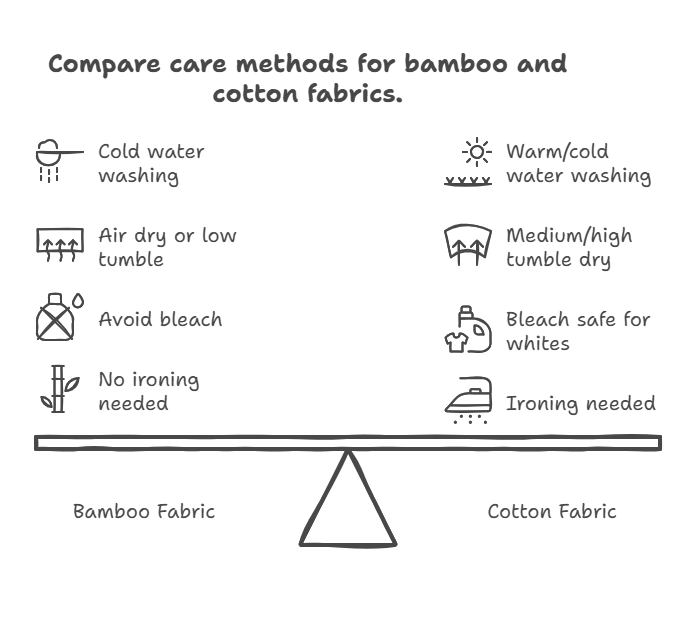
FAQs About Bamboo and Cotton Fabrics
Q: Is bamboo fabric more sustainable than cotton?
A: Bamboo grows faster and uses less water, but chemical processing for bamboo rayon can reduce its eco-friendliness. Organic cotton is a greener alternative to conventional cotton.
Q: Which fabric is softer?
A: Bamboo rayon is silkier from the start, while cotton softens with repeated washing.
Q: Can bamboo or cotton cause allergies?
A: Bamboo is naturally hypoallergenic, ideal for sensitive skin. Organic cotton is less likely to cause reactions than chemically treated cotton.
Q: Which is better for bedding?
A: Bamboo suits hot sleepers due to its breathability and softness. Cotton is great for durable, crisp sheets.
Q: How does the price of organic cotton compare to conventional cotton?
A: Organic cotton is typically 20-30% more expensive due to sustainable farming practices, but it’s kinder to the environment and skin.
Q: How can I ensure bamboo fabric is eco-friendly?
A: Look for mechanically processed bamboo or certifications like OEKO-TEX or GOTS for sustainable production.
Explore our sustainable fabric collection or dive into our eco-friendly care guide to make your wardrobe greener! Have questions? Share them in the comments below!
Table of Contents
- Table of Contents
- Why Choose Between Bamboo and Cotton Fabrics?
- How Are Bamboo and Cotton Fabrics Produced?
- Bamboo vs Cotton: Key Differences
- Benefits and Drawbacks of Bamboo Fabric
- Benefits and Drawbacks of Cotton Fabric
- Which Fabric Is Best for Your Lifestyle?
- How to Care for Bamboo and Cotton Fabrics
- FAQs About Bamboo and Cotton Fabrics

